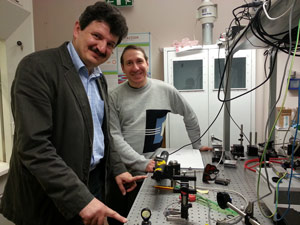- News
14 March 2013
EU-supported €11.8m NEWLED project to ‘revolutionize’ LED lighting
The €11.8m pan-European project NEWLED (‘Nanostructured Efficient White LEDs based on short-period superlattices and quantum dots’) is aiming to develop a new generation of 50-60% energy-efficient white light-emitting LED lights, which would be more than twice as efficient as existing LED-based bulbs. The project leaders, based at the University of Dundee in Scotland, say that the higher-efficiency white-light LEDs, if widely implemented, could have a significant effect on reducing global energy consumption and CO2 emissions.
The European-wide research project is focused on achieving high-efficiency and high-brightness monolithic and hybrid all-semiconductor white light-emitting gallium nitride (GaN)-based diodes. The NEWLED project brings together a wide range of academic and industrial partners and is funded through the European Union’s FP7 program (see partners below).
"Common light bulbs have a pretty low efficiency rating and even the best current white LEDs in use only have an overall efficiency of around 25%,” commented NEWLED project leader professor Edik Rafailov, who is based in the School of Engineering, Physics & Mathematics at Dundee.
 Picture:
Professor Edik Rafailov, leader of the Newled project.
Picture:
Professor Edik Rafailov, leader of the Newled project.
“What we are aiming to develop is a significantly more efficient white LED, which would be around 50-60% efficient. If we can achieve that and they subsequently become widely adopted, then the effects on overall energy consumption would be enormous. Such LEDs would also enable lighting over which much more control could be exercised in brightness and tone."
Power losses due to phosphor conversion and the problem of different ageing rates of the GaN LED pump will be eliminated by the development of phosphor-free structures with increased brightness (power emitted per surface per angle). NEWLED aims to enhance the efficiency of yellow InGaAlP/AlGaAs LEDs by using a bandgap-engineered superlattice design.
Novel light extraction approaches will target advanced directionality and colour adjustment. Values of 50-60% overall efficiency with a conversion of greater than 200lm/W in the exploited warm white LEDs are targeted as well as the realization of a colour rendering index (CRI) of greater than 95.
Advanced packaging will enable effective heat dissipation and light management. The devices can have immediate applications in automotive, industrial lighting and displays industries. Widespread implementation could reduce global energy consumption by about 10% and reduce CO2 emissions by 3bn tones, with consequent economic and environmental benefits, it is reckoned.
The effort to produce highly efficient white LEDs will see the project examine each stage of the LED fabrication process, from developing new knowledge on the control of semiconductor properties on a near-atomistic level to light mixing and heat management.
By examining the entire process, NEWLED aims to ensure that the LEDs will be well adjusted to avoid compromising the achievements of the overall process and to ensure significant system and operating cost reduction.
Project details
The NEWLEDS project commenced in November and will run for four years until the end of October 2016. Project costs are budgeted to be €11.8m, with funding of €8.4m already committed from the EU’s FP7 Seventh Framework Programme.
Besides Dundee, the 13 other participants are: Universita Degli Studi Di Roma Tor Vergata in Rome, Italy; Technische Universität Berlin and VI Systems of Berlin, Germany; Top-Gan of Warsaw, Poland; CNRS in Paris, France; M-Squared Lasers Ltd and Compound Semiconductor Technologies Global Ltd in Glasgow, UK; Osram Opto Semiconductors GmbH of Regensburg, Germany; Vilnius University in Lithuania; IOFFE Physico-Techhnical Institute of the Russian Academy of Sciences in St Petersburg; Lux-TSI Ltd in Pencoed Technology Park, UK; and the Optoelectronics Research Centre of Tampere, Finland.
www.dundee.ac.uk/elecengphysics/research/
By Matthew Peach, Contributing Editor



